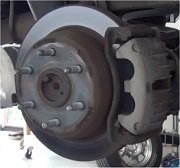Hi cuyler2006. Welcome to the forum. First of all, be sure the caliper can slide freely on its mounts and bolts. If any mounting bolts have rust pits, the caliper will not release properly. Since you replaced the calipers already, we can rule out sticking pistons. Something else is keeping that caliper applied. To prove this, jack that wheel up and try to spin the wheel by hand. If it does spin freely, apply and release the brake pedal a couple of times, then see if the caliper released. When you catch it sticking, loosen the steel lines at the master cylinder. No air will enter the hydraulic system if you leave the master cylinder cap loose momentarily. If the brake releases, suspect the brake fluid is contaminated with petroleum product such as power steering fluid, engine oil, or transmission fluid. I think this isn't your problem because it should affect the left front caliper at the same time.
If the brake doesn't release by opening the lines at the master cylinder, open the caliper's bleeder screw. If that allows the caliper to release, suspect a constricted rubber hose. I can't remember what the rear hoses look like, but if they have a metal anchor bracket in the middle, suspect rust buildup inside where the bracket is crimped around the hose. Pedal pressure is plenty strong enough to force fluid to the caliper, but it will remain trapped by the constricted hose. As the brake heats up, the fluid will also heat up and expand. That applies the brake harder and produces more heat. A little fluid will sneak through the constriction and go back to the reservoir, then, when the fluid cools down, the brake will gradually release.
Caradiodoc
Saturday, April 10th, 2010 AT 10:39 PM




